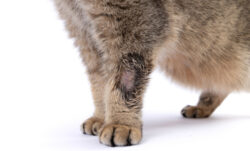What Is Ringworm in Cats? Symptoms, Causes, Diagnosis, Treatment, and Prevention
September 27, 2023 8:43 pm Ringworm is a common fungal infection that can affect various species, including cats. Despite its name, ringworm is not caused by a worm but by a group of fungi known as dermatophytes. These fungi thrive on dead skin and hair, and they are highly contagious. Understanding the symptoms, causes, diagnosis, treatment, and prevention of ringworm in cats is crucial for ensuring their well-being and preventing the spread of infection to other pets, as well as humans.
Ringworm is a common fungal infection that can affect various species, including cats. Despite its name, ringworm is not caused by a worm but by a group of fungi known as dermatophytes. These fungi thrive on dead skin and hair, and they are highly contagious. Understanding the symptoms, causes, diagnosis, treatment, and prevention of ringworm in cats is crucial for ensuring their well-being and preventing the spread of infection to other pets, as well as humans.
Symptoms of Ringworm in Cats
Ringworm in cats often presents with distinctive signs that can be identified with careful observation. One of the most common symptoms is the development of circular or irregularly shaped areas of hair loss. These areas may appear dull, scaly, or crusty in nature. Additionally, the skin underneath the affected area might show redness, inflammation, or sores. It’s worth noting that while the term “ringworm” implies a circular lesion, not all cases exhibit this classic appearance. In some instances, the condition may simply manifest as a diffused patch of hair loss.
Causes of Ringworm in Cats
Cats can contract ringworm through direct contact with infected animals, primarily other cats. The fungal spores can be present on the fur, claws, bedding, or even in the environment. Kittens, elderly cats, or cats with compromised immune systems are particularly susceptible to ringworm. The infection can also be transmitted indirectly through contaminated objects, such as grooming tools, bedding, and furniture. As ringworm spores can survive in the environment for prolonged periods, these contaminated objects can contribute to the spread of the infection.
Diagnosis of Ringworm in Cats
Diagnosing ringworm in cats usually involves a combination of visual examination, microscopic evaluation, and fungal culture. Veterinarians often perform a Wood’s lamp examination, which involves shining an ultraviolet light on the affected area. However, it’s important to note that not all forms of ringworm fluoresce under a Wood’s lamp, so additional tests are necessary for confirmation. Microscopic evaluation of hair samples collected from the affected areas is another diagnostic approach. A positive fungal culture is the most definitive method for confirming ringworm infection. This entails taking hair samples and placing them on a special medium to determine if the dermatophyte fungi grow.
Treatment of Ringworm in Cats
Treating ringworm in cats involves a combination of topical and systemic therapy. Antifungal shampoos, dips, or creams are typically used to treat localized lesions on the skin. Clipping of the hair around affected areas may also aid in treatment. Additionally, oral antifungal medications are often prescribed to treat systemic infections. The duration of treatment can vary depending on the severity of the infection, and it’s important to complete the full course of medication as prescribed. Regular follow-up visits to the veterinarian are crucial to monitor progress and ensure successful recovery.
Prevention of Ringworm in Cats
Preventing ringworm in cats can be challenging, but there are measures that can decrease the risk of infection. Regular grooming and bathing can help in the early detection of any skin abnormalities and reduce the fungal load on the fur. Disinfecting grooming tools, litter boxes, and bedding regularly is crucial to prevent the spread of the infection to other pets or humans in the household. Isolating infected cats and minimizing their contact with other animals can also aid in prevention. Furthermore, having new pets examined by a veterinarian and screened for ringworm before introducing them into a multi-cat household is essential.
Conclusion
Ringworm is a contagious fungal infection that can affect cats and other animals. Recognizing the symptoms, understanding the causes, and seeking prompt veterinary care are important for appropriate diagnosis and treatment. While the infection can be challenging to eradicate, following preventive measures such as regular grooming, disinfection, and isolation can minimize the risk of contracting or spreading ringworm in cats. By staying vigilant and implementing effective preventive strategies, pet owners can ensure the health and well-being of their feline companions while reducing the risk of transmission to others.
Got Questions? Let Us Help!
Categorised in: Diseases in Cats
This post was written by admin
